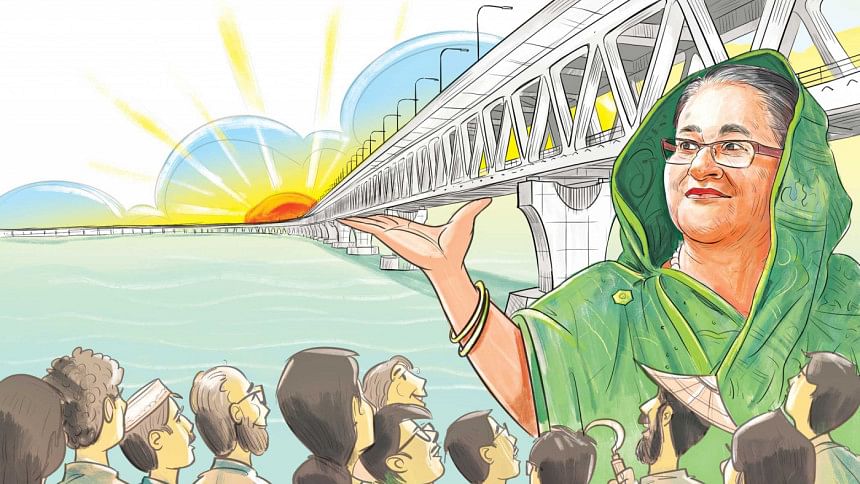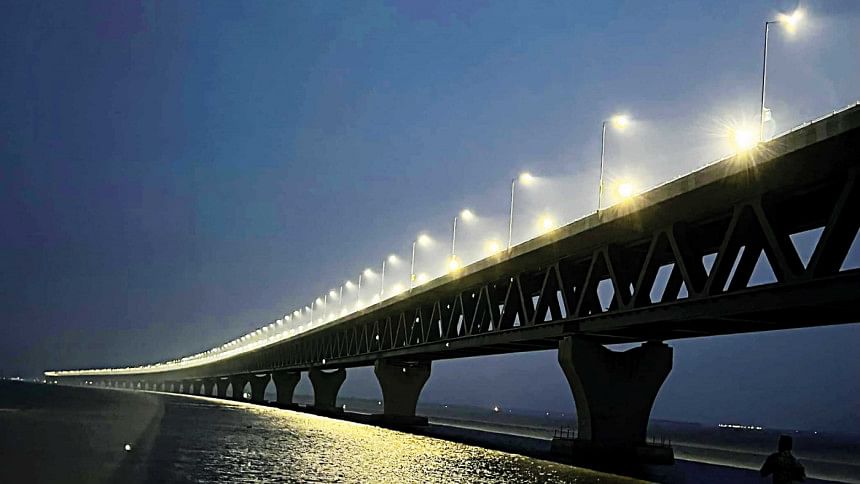Built by Bangladesh

When it comes to high achievement, it is almost always fuelled by high expectations. Going by that thinking, the much-awaited Padma bridge, whose inauguration takes place today, is gearing to be a high achiever when it comes to economic benefits.
Constructed at a cost of about Tk 30,193 crore, the 6.15-kilometre-long bridge will be connecting the backward southwest region with the rest of the country.
In so doing, it would be adding 1.2 percent to 1.7 percent to Bangladesh's GDP every year, and the southwest region's GDP by as much as 35 percent -- and this is no little achievement.
At least 30 million people, almost one-fifth of the country's total population, will directly benefit from the bridge, set to be the largest in Bangladesh, according to a study by the World Bank.
As with the Jamuna bridge, positive impacts are expected on poverty alleviation in the southwest region, particularly in Khulna and Barishal divisions.
"There would be both tangible and intangible benefits," said Mustafizur Rahman, distinguished fellow of the Centre for Policy Dialogue.
The intangible benefit comes in the form of economic pride that this bridge on Padma River has come to represent.
Originally planned to be built with funding from the World Bank, the Washington-based multilateral lender in 2012 pulled out from the project on allegations of corruption, which were later found to be not true.
But this did not dither Prime Minister Sheikh Hasina from the goal, which was to build an integrated and well-connected economy to match the country's aspirations of becoming an advanced nation by 2041.

She decided to build the bridge with the government's own funding and delivered on that proclamation.
"This is a great confidence booster for the country," Rahman said.
It will help in the country's branding as an emerging economic force to reckon with, improve the international credit rating and change the perception of Bangladesh in the world.
Furthermore, it led to both capital and human capital development.
"All of it will have a positive role in future.
We cannot see them now but these will have some monetary value in future," he said.
Constructed at a cost of about Tk 30,193 crore, the 6.15-kilometre-long bridge will be connecting the backward southwest region with the rest of the country. In so doing, it would be adding 1.2 percent to 1.7 percent to Bangladesh's GDP every year.
The tangible benefits would come in the lessening of travel time between the Dhaka division and the southwest region and possibly on to India.
Travel time savings are expected to be about two hours for cars and buses and more than 10 hours for trucks.
This will bring down the cost of passenger and commodity movement, vehicle operation and maintenance costs and reduce the wasteful burning of fossil fuels.
"A neglected region will get connected to the mainstream economy. This will play a positive role in inclusive development," Rahman said, adding that there would be visible impacts on marketing, distribution, efficiency and timeliness of delivery of consignments from the region.
The market for perishables from the southwest region will widen as truckers would be able to carry the produce to Dhaka on the same day, said Zahid Hussain, a former lead economist of the World Bank's Dhaka office.
That also means the farmers and fishermen would get better prices.
"This will work as an incentive for them to scale up their production."
In other words, the bridge will yield an agricultural boost.
Inter-district commerce would grow too.
"From commerce, the focus would then shift to production. You increase your production by investing."
Given the backward nature of the region, land availability is easier, still.
Getting workable land near Dhaka or Chittagong is hard and costly. But the land prices in the Khulna region are still reasonable, Hussain said.
"Since connectivity is no longer an issue, investment interest will increase. Even if there is no improvement in the regulatory environment, there would still be benefits," Hussain said.
Because of the superlative connectivity thanks to the Padma bridge, the Payra deep seaport and the Mongla port would become viable too, according to Rahman.
The bridge would also serve as a transmission channel for gas and electricity.
"Economic benefits would come in many ways," said Ahsan H Mansur, executive director of Policy Research Institute.
The southwest region is home to the Sundarbans and Kuakata, two tourist attractions that are not easily accessible.
"A tourism industry will burgeon based on the Padma bridge. People would come to see the Padma bridge and also go forth to the Sundarbans," Hussain said.
However, for the Padma bridge to be truly epoch-making, the southwest region needs to be transformed into an economic corridor.
"The benefits will multiply then," Rahman said.
For that, the planned special economic zones must have a good service delivery, a conducive business environment and skilled manpower.
"Only then would the investment flow in -- we must pay attention to this. Parallel initiatives are necessary too to get the full benefits," Rahman added.
Hussain said the economic incentives to fix the existing problems for border trade issues including custom procedural harmonisation have vastly improved.
There are good chances of investment flowing in from India because of its proximity to the neighbouring country, according to Mansur.
"If the government can implement the economic corridors planned, this area can be revitalised. This will have a serious impact, which will be hard to quantify now," he added.

 For all latest news, follow The Daily Star's Google News channel.
For all latest news, follow The Daily Star's Google News channel. 



Comments